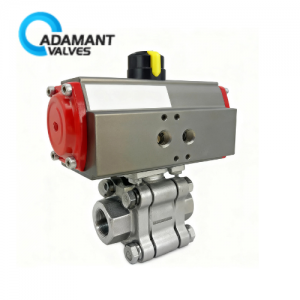Six Characteristics of the Ball Valve

What is Sanitary Ball Valve?
Sanitary Ball valve is the advent of a new type of valve in the 50s of the last century. Over 30 years, the ball valve has developed into a major kind of valve, which is widely used in aerospace, petrochemicals, long-distance pipelines, light industrial products, construction, and many other fields. This is because the ball valve has many outstanding advantages compared with other valves. The main features of the ball valve are as follows:

Six Characteristics of the Ball Valves
(1) Small fluid resistance.
Ball valves are generally divided into reduced diameter and non-reduced diameter channels of these two structures. No matter what kind of structure it is, the ball valve flow resistance coefficient is relatively small. In particular, the so-called full-flow type, that is, the reduced diameter of the ball valve, from the diameter of its channel equal to the diameter of the pipeline, local resistance loss is only the same length of the pipeline frictional resistance. In all valves, this valve has the smallest flow resistance.
In the rocket launch and its test system, the resistance of the pipeline needs to be as small as possible. There are two ways to reduce the resistance of the pipeline system. One is to reduce the fluid velocity. To do this, it is necessary to increase the pipe diameter and the valve back-off, which often have an adverse effect on the economy of the pipe system. It is extremely unfavorable to hold the low-temperature delivery system (liquid hydrogen), so the ball valve has naturally become the best choice.
(2) Switch quickly and easily.
As the ball valve under normal circumstances only needs to handle the rotation of 90 degrees to complete the full turn into full-off action, it is easy to achieve quick opening and closing.
(3) Good sealing.
At present, the vast majority of valve seats are made of polytetrafluoroethylene and other flexible materials. Seals composed of metallic and non-metallic materials are often referred to as soft seals. In general, the soft seal of the seal is easy to guarantee, but also on the sealing surface of the machining accuracy and surface roughness requirements are not high.
(4) Long life.
Since PTFE has good self-lubricating properties, friction and wears with the sphere are small. And due to the improvement of ball processing technology to reduce the roughness, ball valve life has been extended. It is reported that the United States W-K-M company in the test chamber on the life of the ball valve test, switching over 100,000 times.
(5) High reliability.
The high reliability of the ball valve is mainly because ① ball and seat pair of sealing pair will not occur abrasions, rapid wear and tear, and other failures. It does not get stuck when working (in the absence of lubricant), it can be reliably applied with corrosive media and low boiling point liquid; ② built-stem structure, eliminating the valve stem under the fluid pressure may be due to packing Gland loose and fly out of the hidden dangers of the accident; ③ anti-static, the fire-resistant structure of the ball valve, is suitable for transporting oil, natural gas, gas pipeline.
(6) The valve body has smooth channels.
It is more suitable for conveying viscous fluids, slurries and solid particles.




